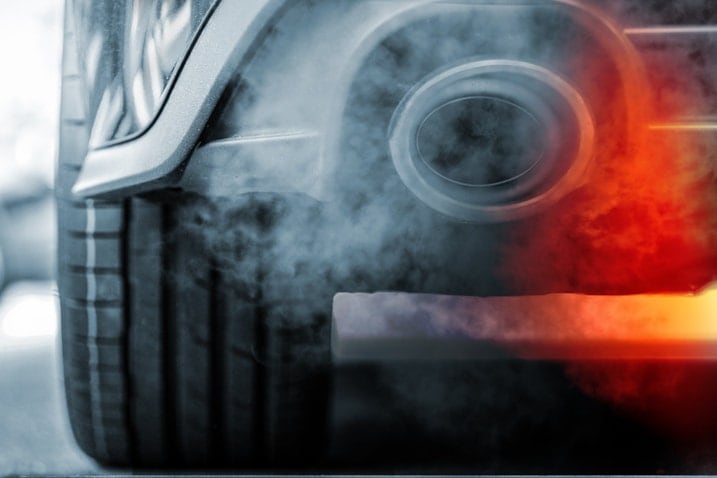Photo: deepblue4you | Getty Images
Modern cars are so clean and efficient that it's easy to forget they're powered by a combustion engine. It doesn't take a skilled mechanic to notice your car's engine is producing visible smoke. But did you know the color of the smoke coming from the exhaust can help you diagnose the fault?
What does white smoke coming from an exhaust mean?
Exhaust smoke can vary in thickness and color depending on what's in it. As a rule of thumb, the colors mean the following:
White smoke: This has a lot of water vapor in it.
Blue smoke: Burning oil produces exhaust emissions with a blue tinge.
Black smoke: This indicates the air-to-fuel ratio is off, suggesting a sensor problem.
If your car is producing a small amount of white exhaust smoke — for example, after being started on a cold morning — you don't have to worry too much. Condensation commonly builds up within the exhaust on a cold day, and when you start driving, the heat causes that condensation to evaporate, producing a thin trail of vapor, which looks like smoke.
If you notice thick white smoke, however, it may indicate a problem with the engine.
Common causes of white smoke
While the white vapor that appears briefly when you start your car or accelerate for the first time is harmless, persistent thicker smoke could be a sign of a blown head gasket, cracked engine block or damaged cylinder.
All of the above potential causes have one thing in common: They can lead to depleted coolant levels. The white smoke is most likely coolant being burnt ed off.
Continuing to drive could lead to your engine overheating, and in some cases, coolant mixing with engine oil. If you notice thick white smoke coming from your exhaust, call a mechanic as soon as possible, and try not to drive any farther than you have to.
How the combustion process works
Internal combustion engines work by burning fuel in the presence of air and using that energy to move pistons. These pistons move up and down in cylinders, and they are connected to something called a crankshaft that turns that up-and-down motion into circular motion to drive the vehicle's wheels. It's an impressive system that requires a perfect balance of fuel, air and oil for the vehicle to work at peak efficiency.
In a gas-powered vehicle, fuel is mixed with air, which is then sent into the engine's cylinder. A piston compresses the fuel-air mixture and a spark ignites it, causing the fuel to burn. As the fuel burns, the gases in the air expand, which pushes the piston.
Fuel injectors help manage this process, ensuring the right amount of fuel is brought into the cylinder at the right time. They have electronically operated valves managed by the engine control computer and can open and close dozens of times per second. A faulty sensor or fuel injector could lead to the fuel-to-air ratio becoming incorrect, leading to poor performance or odd smoke coming from your exhaust.
What role does the head gasket play in an engine?
The head gasket is located between the cylinder head at the top of the engine and the main engine block. It serves as a seal, helping stop coolant and oil from mixing together. If this gasket fails, the results can be catastrophic, and one of the first warning signs of an issue is white smoke coming from your exhaust.
The head gasket seals the oil pathways between the engine block and the cylinder head while also allowing coolant to flow to the proper areas. If it's improperly installed or has failed, you may notice a loss of engine power, overheating, or the dreaded white smoke coming from the exhaust.
A blown head gasket can be an expensive problem to fix, and it's a good idea to have a professional mechanic take a look at the engine to narrow down the cause of the problem.
Piston ring issues as a cause of exhaust smoke
Piston rings are small components mounted on the pistons in the combustion cylinder. Their job is to maintain pressure within the system so the pistons move properly.
Over time, these rings can become brittle or worn and no longer form a tight seal. This issue results in poorer engine performance. If the seal becomes so poor that oil can enter the combustion chamber, the most noticeable symptoms will be a foul odor and dark gray or bluish smoke.
Worn piston rings are unlikely to cause white smoke unless there's a coolant leak as well and the pistons are allowing water into the chamber. However, if you're noticing poor engine performance, increased oil consumption and odd-colored exhaust, the piston rings could be behind the problem.
Don't ignore a smoky exhaust
Your car's exhaust is a useful indicator of its engine health. If you notice it's thicker than normal, a different color, or just smells different than usual, think of that as your car trying to tell you something. Don't ignore these warning signs even if your vehicle seems to be performing the same. Exhaust issues are unlikely to get better on their own, and if you try to drive a car with insufficient coolant, you could do even more damage.
If you notice white, blue or black smoke coming from your car's exhaust, take it to a garage as soon as possible. You'll help prevent further damage to the engine and give yourself the best possible chance of an inexpensive, successful and long-lasting repair.


 by
by  edited by
edited by 
